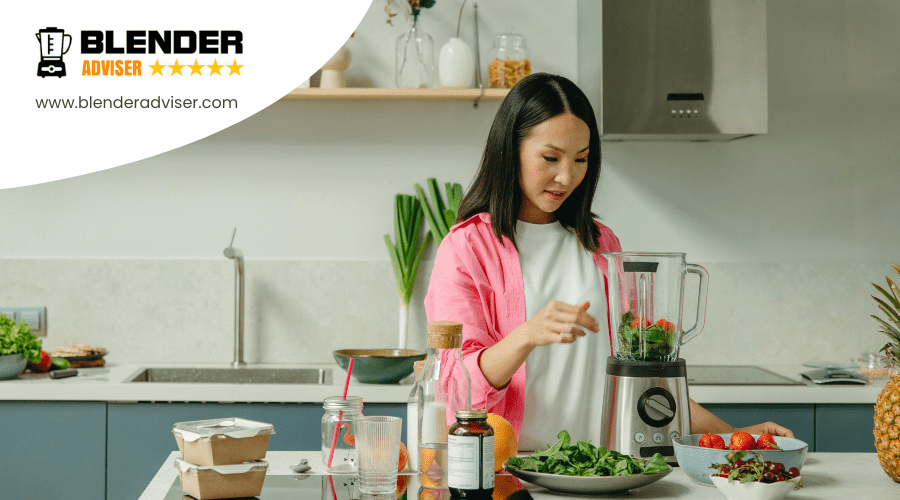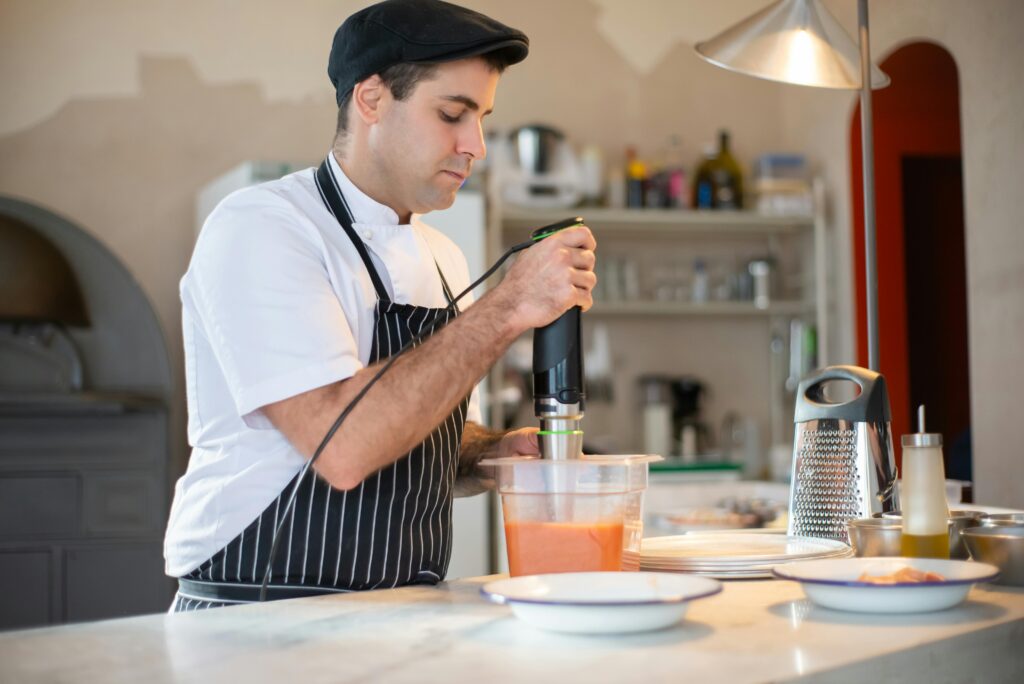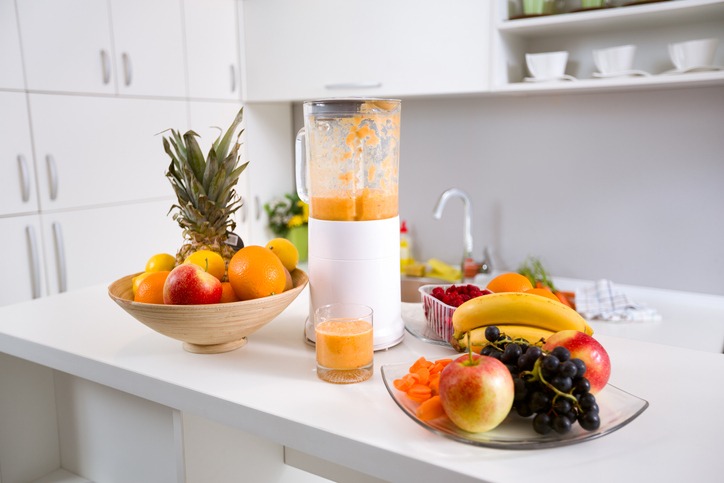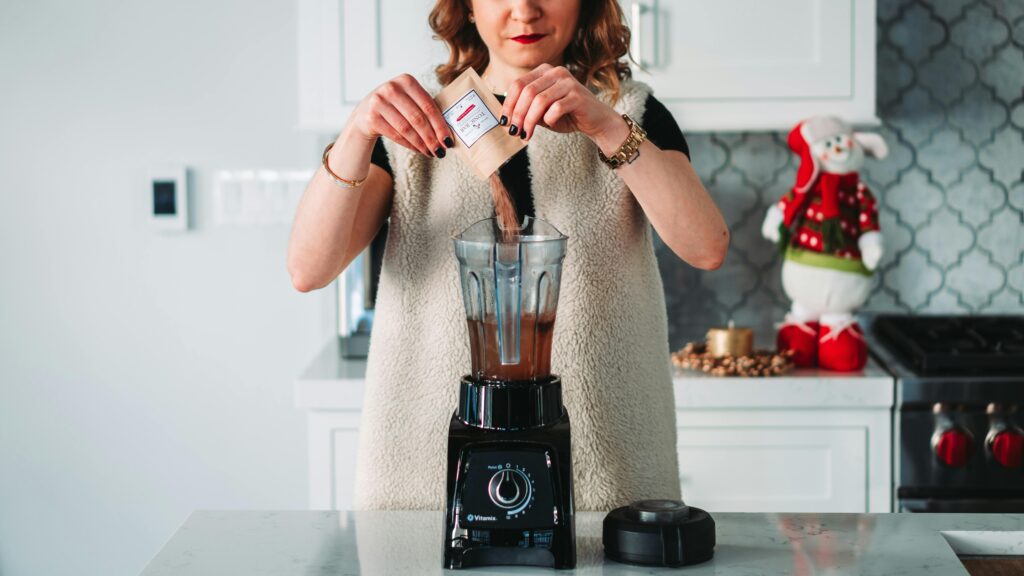While you might believe that any blender can get the job done, the truth is, different types of blenders cater to specific needs and preferences. You’ve likely encountered countertop, immersion, and personal blenders, but understanding their distinct advantages and limitations is crucial for making an informed decision.
Whether you’re blending smoothies for one or soups for the whole family, there’s a model that fits your lifestyle perfectly. Let’s explore what sets these blenders apart, sparking a conversation on how to select the ideal type that aligns with your culinary ambitions.
Countertop Blenders
Countertop blenders, designed to be a kitchen staple, offer a variety of sizes and power options to meet your blending needs. When you’re looking to make smoothies, soups, or sauces, the right blender can make all the difference. With their powerful motors and sharp blades, these blenders easily handle a wide range of ingredients, turning them into smooth, consistent mixtures in no time. The best part? They’re incredibly easy to use. You don’t need to be a professional chef to master the art of blending.
The key to finding the best countertop blender for you lies in understanding what you’ll primarily use it for. If you’re into making thick, creamy soups or nut butters, you’ll want a blender with a lot of power to process those tougher ingredients. On the other hand, if smoothies are your go-to, ensure the blender’s blades are designed to crush ice and frozen fruit efficiently. Additionally, many models come with pre-programmed settings, making it easier than ever to achieve the perfect consistency for your food without the guesswork.
Immersion Blenders
Now, let’s turn your attention to immersion blenders, a handy tool in your culinary arsenal. You’ll learn how they operate, ensuring you can blend soups and sauces right in the pot with ease. We’ll also cover the essentials of keeping them clean and the myriad ways they can be used to enhance your cooking experience.
How Immersion Blenders Work
Diving into how immersion blenders work, these versatile tools blend ingredients directly in the pot or container they’re cooked in, making them a kitchen essential. Also known as stick blenders, they feature a long design with a blending arm that’s immersed into your food or liquid.
You’ll find them ideal for blending hot soups, sauces, and more without the need to transfer contents to a separate blender. They typically offer a range of speeds, giving you control over the blending process. Some models even include whisk heads, adding to their versatility.
The blending is achieved through exposed blades at the arm’s end, requiring your pressure and movement to mix ingredients thoroughly. This method ensures a seamless blending experience, directly in your cooking vessel.
Cleaning and Maintenance Tips
After exploring how immersion blenders work, let’s focus on keeping them in top condition with some essential cleaning and maintenance tips.
- Detach the blending arm from the motor unit to clean them separately. This ensures that you can thoroughly clean the blending arm without risking damage to the motor unit.
- Wash the blending arm in warm soapy water, meticulously removing all food residue to prevent bacteria growth and maintain hygiene.
- Avoid submerging the motor unit in water. Instead, wipe it down with a damp cloth and dry it well to prevent any electrical issues.
- Regularly check and clean the blade guard for food buildup. This is crucial for maintaining optimal blending performance and ensuring your immersion blender works efficiently.
- Dry the blending arm thoroughly before reassembling the immersion blender to avoid any water damage or rust.
Following these steps will help keep your immersion blender clean and in good working condition.
Popular Uses in Kitchens
Immersion blenders have become a kitchen staple for effortlessly blending soups, sauces, and smoothies right in their cooking containers. These versatile tools excel at emulsifying dressings, pureeing vegetables, and achieving creamy textures that elevate every meal.
Their compact size is a perfect fit for small kitchen spaces, ensuring you can whip up your favorite dishes without clutter. Thanks to various attachments, like whisk attachments, you’re equipped to tackle a wide range of cooking tasks beyond blending.
What’s more, immersion blenders are praised for their ease of cleaning, making them a go-to for daily use. Whether you’re concocting a velvety soup or a refreshing smoothie, these blenders streamline the process, ensuring delicious results with minimal fuss.
Personal or Portable Blenders
Personal or portable blenders, compact companions for your on-the-go lifestyle, streamline the process of making single-serving smoothies or shakes. These personal blenders are a game-changer for anyone with a busy schedule. They’re designed for on-the-go use, making them perfect for quick breakfasts, post-workout refreshments, or nutritious snacks while traveling. Thanks to their size, they can easily blend soft ingredients like fruits, creating delicious smoothies or shakes in no time. Plus, many models come with resealable lids for travel cups, so you can blend and go without transferring your drink. The convenience doesn’t stop there; these portable blenders often feature removable blades, making cleanup a breeze.
Imagine the possibilities:
- Whipping up a berry smoothie in your hotel room
- Enjoying a protein shake right after your gym session
- Preparing a quick breakfast smoothie as you head out the door
- Easily cleaning the blender in between uses
- Taking your blender on trips without it taking up much space
Personal blenders are all about convenience, making them an essential tool for anyone looking to maintain a healthy lifestyle without sacrificing time.
Commercial Blenders
Commercial blenders are built to handle the rigorous demands of professional kitchens and bars, effortlessly mixing large volumes of ingredients for smoothies, cocktails, and more. These powerful machines are designed for high-volume use in professional settings, ensuring that whether you’re blending a creamy soup or a signature cocktail, you’re equipped with the right tool for the job.
Within the category of commercial blenders, you’ll find food blenders, bar blenders, and immersion blenders, each tailored for specific applications. Food blenders excel in creating thick drinks, soups, and sauces, capable of continuous operation without the risk of overheating. This makes them ideal for kitchens where efficiency and durability are paramount.
On the other hand, bar blenders are the go-to for any mixologist aiming to craft the perfect cocktail. They often come with sound enclosures to minimize noise, making them a perfect fit for bustling bars where maintaining ambiance is key.
Choosing the Right Blender
After exploring the ins and outs of commercial blenders, it’s crucial to consider what you’ll need for your specific blending tasks before making a purchase. The variety of blenders available means there’s a perfect type of blender for every need, whether you’re running a smoothie shop or simply enjoy homemade soups.
When choosing the right blender, consider these points:
- Intended Use: Are you crushing ice for smoothies, or do you need a blender for that purpose specifically? Personal blenders are designed for quick, easy smoothies with safety features for blade handling.
- Quantity: If you’re preparing large batches, a commercial blender or a kitchen blender with a sizeable Blending Jar might be necessary.
- Type of Food: Immersion blenders are ideal for soups and stickier foods, given their handheld design.
- Space and Storage: Commercial blenders offer powerful performance but can be bulky and challenging to store.
- Ease of Cleaning: Some main types of blenders may be harder to clean than others, a critical consideration when choosing.
Care and Maintenance Tips
To keep your blender in top shape, you’ll need to focus on two key areas: cleaning routine essentials and preventive maintenance steps.
Ensuring you clean the jar, lid, and blades after every use will ward off residue buildup. Additionally, regularly checking and tightening its base and blade assembly can save you from future hassles and keep your blender running smoothly.
Cleaning Routine Essentials
Maintaining your blender in top condition requires a regular cleaning routine that not only prevents food buildup but also ensures its optimal performance. By adhering to a few blender maintenance tips, you’ll keep your appliance running smoothly.
- Disassembly: Carefully take apart your blender for thorough cleaning.
- Cleaning Solution: Mix water, baking soda, and vinegar to tackle tough stains and odors.
- Blade Cleaning: Use a brush and warm, soapy water to scrub the blades and pitcher.
- Drying Components: Ensure all parts are completely dry before reassembling to prevent mold.
- Manufacturer’s Instructions: Always follow the provided guidelines for optimal blender maintenance.
Preventive Maintenance Steps
Regular cleaning of your blender’s jar, lid, and blades with warm, soapy water can significantly reduce residue buildup and keep your appliance in pristine condition. To ensure your blender’s longevity and safety, follow these blender care tips closely.
| Maintenance Task | Why It’s Important | How Often |
|---|---|---|
| Clean blender regularly | Prevent residue buildup | After each use |
| Tighten blender base screws | Ensure stability during operation | Monthly |
| Inspect power cord | Prevent electrical hazards | Every 6 months |
| Lubricate motor bearings | Maintain optimal performance | As manufacturer recommends |
| Store blender properly | Prolong blender lifespan | After each use |
Conclusion
In conclusion, whether you’re whipping up smoothies, soups, or sauces, there’s a blender out there for you. From the versatile countertop models, handy immersion blenders, to the on-the-go personal blenders, and the robust commercial versions, your perfect match depends on your specific needs.
Don’t forget, choosing the right blender is just the start; taking good care of it ensures it’ll keep mixing up your favorites for years. So, consider your options, pick wisely, and blend away!





